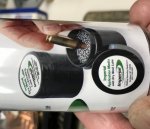To avoid the so called "cold weld" between bullet and case, anybody tried applying a bullet lubricant like liquid alox from Lee, commonly used on cast lead bullets?
Roll the bullets over a small amount of alox.
Allow to dry and seat them.
Remove the excess from the bullet and neck.
Will try it soon
Roll the bullets over a small amount of alox.
Allow to dry and seat them.
Remove the excess from the bullet and neck.
Will try it soon

